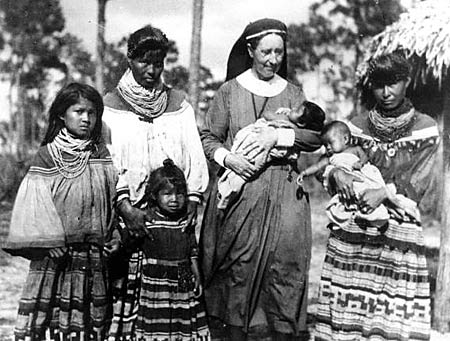Readings:
Exodus 2:1-10
Psalm 93;
1 Corinthians 1:4-9;
Matthew 5:43-48Preface of Apostles and Ordinations
[Common of a Missionary]
[Common of a Pastor]
[For the Ministry]
[For the Mission of the Church]
PRAYER (traditional language)
Holy God, fill us with compassion and respect for all people, and empower us for the work of ministry whether near or far away; that like thy servant Harriet Bedell, we may show forth thy praise, not only with our lips, but in our lives, and by giving up ourselves to thy service. Through Jesus Christ our Lord, who liveth and reigneth with thee and the Holy Ghost, one God, for ever and ever. Amen.
PRAYER (contemporary language)
Holy God, fill us with compassion and respect for all people, and empower us for the work of ministry whether near or far away; that like thy servant Harriet Bedell, we may show forth your praise, not only with our lips, but in our lives, and by giving up ourselves to your service. Through Jesus Christ our Lord, who lives and reigns with you and the Holy Spirit, one God, for ever and ever. Amen.
Lessons revised at General Convention 2024.
Return to Lectionary Home Page
Webmaster: Charles Wohlers
Last updated: 9 November 2024
HARRIET BEDELL
DEACONESS AND MISSIONARY
(8 January 1969)
Harriet Bedell, missionary and friend to the Seminole Indians of Florida, was born in Buffalo, New York on March 19, 1875. She was trained as a schoolteacher but was inspired several years later by an Episcopalian missionary who spoke at her church describing the many needs of missionary work. In 1906 she applied to, and was accepted by, the New York Training School for Deaconesses, where her one-year course of study included instruction in religious matters, missions, teaching, hygiene, and hospital nursing. Following her training she was sent as a missionary-teacher to the Cheyenne Indians at Whirlwind Mission in Oklahoma.
Bedell's duties at the Whirlwind Mission were many. She cared for the sick and the poor, organized social services for the tribe, performed the duties of the rector in his absence, and provided education for the women and children. She provided religious instruction, hoping to win the confidence of the Indians and convert them to Christianity.
Because of her experience in both teaching and working with Indians, in 1916 an Episcopal bishop requested that she consider an assignment in a remote area of Alaska. Saddened by the prospect of leaving Oklahoma, she nevertheless accepted her new assignment in Stevens Village, Alaska. While there, in 1922 she was finally made a deaconess in the church, instilling in her a new and profound dedication to her vocation. The mission at Stevens Village was moved to Tanana so that a boarding school funded by church members' contributions could be established for the children who could not travel in the bad winter weather. However, by 1931, funds were so scarce that Deaconess Bedell traveled to New York to plea for more contributions. Because of the Great Depression, there was little available money, and although the church paid off the school's existing debt, there was little reason for Bedell to return to Alaska.

Through speaking engagements following her service in Alaska, Bedell was invited to visit a Seminole Indian reservation in southern Florida. Appalled by their living conditions, she began her campaign to improve the quality of life among the Mikasuki-Seminole Indians by living and working with them, not merely teaching them. She sought to revive the doll making and basket weaving skills which had become nearly extinct. She encouraged the incorporation of the intricate patchwork designs made by Indian women into articles of clothing for both women and men. Sales from the arts and crafts store at Blades Cross Mission helped to provide improved income for the Mikasuki-Seminoles.
Bedell emphasized health and education rather than religious conversion in her work with the Seminoles; their spiritual and physical comfort was more important to her than religious conversion, and her work and friendship with the Seminoles of Florida reflected those values.
from the Florida Memory Project